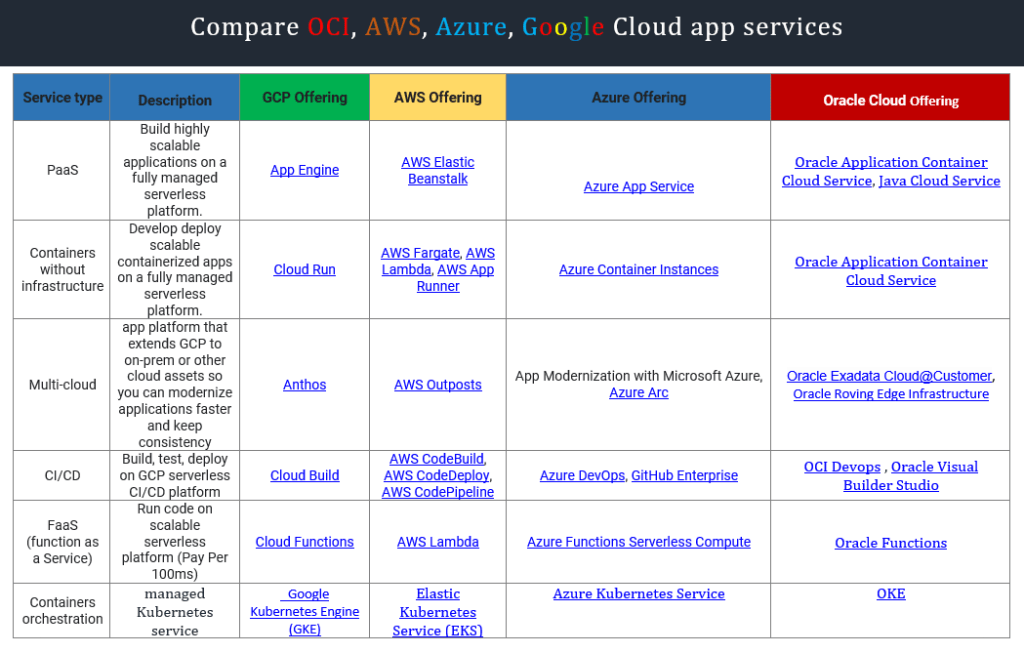OCI FortiGate HA Cluster – Reference Architecture: Code Review and Fixes
Introduction OCI Quick Start repositories on GitHub are collections of Terraform scripts and configurations provided by Oracle. These repositories ... Read More
Learn more about why Eclipsys has been named the 2023 Best Workplaces in Technology and Ontario, Certified as a Great Place to Work in Canada and named Canada’s Top SME Employer!
Learn more!The common trend for cloud providers is to compare their services/offers with AWS (Amazon Web Services – even AWS itself does it when releasing new features). But it seems that the top 3 reached a sort of agreement where they only acknowledge their respective direct competition and dismiss any player outside this oligopoly. The OCI (Oracle Cloud Infrastructure) or AliCloud being more than underdogs deserve a bit more respect when comparing options available out there in the Cloud. That’s why I decided to extend an application services comparison to Oracle Cloud so we can have a broader view of what each one offers.
There are so many ways of designing, building, and deploying an application in the cloud nowadays, whether it’s cloud native-like docker container services, K8, and Faas, or just shift and lift migrations. I almost feel bad for the software developers because there are way too many options that can generate a huge tech debt. Instead of asking which fancy technology to use next, the real question is which one will fit the company’s requirements.
Today, I chose to zoom in on the app services which are here to ease the life of dev teams.
What’s in the comparison
The below table can help visualize which service is available and its equivalent in each of the 4 major Cloud providers.

Compare OCI, AWS, Azure, Google Cloud app services
| Service type | Description | GCP Offering | AWS Offering | Azure Offering | Oracle Cloud Offering |
| PaaS | Build highly scalable applications on a fully managed serverless platform. | App Engine | AWS Elastic Beanstalk | Azure App Service | Oracle Application Container Cloud Service, Java Cloud Service |
| Containers without infrastructure | Develop deploy scalable containerized apps on a fully managed serverless platform. | Cloud Run | AWS Fargate, AWS Lambda, AWS App Runner | Azure Container Instances | Oracle Application Container Cloud Service |
| Multi-cloud | app platform that extends GCP to on-prem or other cloud assets so you can modernize applications faster and keep consistency | Anthos | AWS Outposts | App Modernization with Microsoft Azure, Azure Arc | Oracle Exadata Cloud@Customer, Oracle Roving Edge Infrastructure |
| CI/CD | Build, test, and deploy on GCP serverless CI/CD platform | Cloud Build | AWS CodeBuild, AWS CodeDeploy, AWS CodePipeline | Azure DevOps, GitHub Enterprise | OCI DevOps , Oracle Visual Builder Studio |
| FaaS (The function as a Service) | Run code on a scalable serverless platform (Pay Per 100ms) | Cloud Functions | AWS Lambda | Azure Functions Serverless Compute | Oracle Functions |
| Containers orchestration | managed Kubernetes service | Google Kubernetes Engine (GKE) | Elastic Kubernetes Service (EKS) | Azure Kubernetes Service | OKE |
Although having a lot of choices is generally good, it is important for developers and practitioners to know how every product compares to the competition including the top 5 players. Especially when the company has already adopted the Multi-cloud strategy. Hope this small table helped.
Introduction OCI Quick Start repositories on GitHub are collections of Terraform scripts and configurations provided by Oracle. These repositories ... Read More
Introduction So far, I have used Oracle AutoUpgrade, many times in 3 different OS’. Yet the more you think you’ve seen it all and reached the ... Read More